|
|
 |
Fiche d'espèce de Copépode |
|
|
Cyclopoida ( Ordre ) |
|
|
|
Oncaeidae ( Famille ) |
|
|
|
Oncaea ( Genre ) |
|
|
| |
Oncaea venella Farran, 1929 (F,M) | |
| | | | | | | Syn.: | Oncaea venusta venella Farran, 1929 (p.210, 284, fig.F); Sewell, 1947 (p.263, Rem. F); 1951 (p.371, Rem.: parasites); Tanaka, 1960 (p.72, Rem., small form); Neto & Paiva, 1966 (p.30, Table III, annual cycle); Corral Estrada, 1970 (p.217); Marques, 1973 (p.247); 1975 (p.51); 1976 (p.1001); Boxshall, 1977 a (p.127, fig.11f, Rem.); Vaissière & Séguin, 1980 (p.23, tab.2); Marques, 1982 (p.772); Vives, 1982 (p.295); Malt, 1983 (p.454, fig.F, Rem.); 1983 a (p.5,7, fig.F, Rem.); Böttger-Schnack & al., 1989 (p.1089); Böttger-Schnack, 1994 (p.277); Bersano & Boxshall, 1994 (p.39, Rem.); Böttger-Schnack, 1996 (p.1086); 1995 (p.92); Ohtsuka & al., 1996 a (p.91); Chihara & Murano, 1997 (p.981, Pl.223: F,M); Boxshall, 1998 (p.227); Böttger-Schnack, 2001 (p.37, 46, 53, figs.F,M, Rem.); Heron, 2002 (p.149, figs.F,M, tab.5, Rem.: p.154); Böttger-Schnack & Huys, 2004 (p.2 & suiv.: Rem.); Böttger-Schnack & al., 2004 (p.1130, tab.1, Rem.); Choi & al., 2005 (p.710: Tab.III); Prusova & Smith, 2005 (p.76, 78); McKinnon & al., 2008 (p.844: Tab.1); Wi & al., 2008 (p.187, figs.F,M, Rem.); Böttger-Schnack & Schnack, 2009 (p.131, Table 3); Böttger-Schnack & Schnack, 2009 (p.131, Table 3, 4, Rem.); Selifonova, 2011 a (p.77, Table 1, alien species in Black Sea); Uysal & Shmeleva, 2012 (p.909, Table I) | | | | Ref.: | | | Böttger-Schnack & al., 2001 (p.1029, tab.1, 2); Elvers & al., 2006 (p.504, 505, 511: Rem.); Wi & al., 2008 (p.187, figs.F,M, Rem.); Vives & Shmeleva, 2010 (p.311 Rem.);
Böttger-Schnack & Schnack, 2013 (p. 8, Table 2: Rem.) ; Fuentes-Reinés & Suarez-Morales, 2017 (p.516, Rem.) | 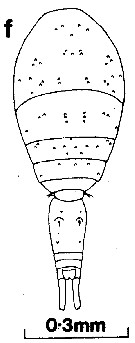 issued from : G.A. Boxshall in Brit. Mus. nat. Hist., Zool., 1977, 31 (3). [p.125, Fig.11, f]. As Oncaea venusta forma venella. Female (from 18°N, 25°W): f, habitus (dorsal)
|
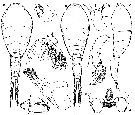 issued from : G.A. Heron in Hydrobiologia, 2002, 480. [p.149, Fig.3]. Female: a-b, c, habitus (dorsal and lateral, respectively; scale bar: u); d, anterior of prosome (ventral; scale bar: x); e, right A2 (scale bar: x); f, labrum (ventral; scale bar: y); g, right Md (scale bar: y); h, left Mx1 (scale bar: y); i, right Mx2 (scale bar: y); j, right Mxp (scale bar: w).
|
 issued from : G.A. Heron in Hydrobiologia, 2002, 480. [p.146, Fig.1]. Scale bars = 0.05 mm.
|
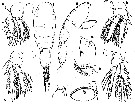 issued from : G.A. Heron in Hydrobiologia, 2002, 480. [p.150, Fig.4]. Female: a-d, P1 to P4 (scale bar: w); e, P5 (scale bar: z). Male: f-g, habitus (dorsal and lateral, respectively; scale bar: v); h, 3rd segment of left A2 (scale bar: x); i, left Mxp (scale bar: w); j, P5 (scale bar: w).
|
 issued from : G.A. Heron in Hydrobiologia, 2002, 480. [p.153, Fig.6]. Female pediger 2-4 and urosome (scale bar: v): a, Oncaea venusta; b, O. frosti; c, O. venella. Nota: O. venella is the smallest of the three species. O. venella is almost identical to O. frosti, except for the less conspicuous body cuticular ornamentation, pediger 2 without a conspicuous mid-dorsal dilation, and the smaller size; the prosome is usually more slender than that of O. frosti, and the female caudal ramus is usually longer than the sum of the preceding three segments; urosome flexed less often than that of O. venusta, but the two postgenital segments and anal segment frequently telescoped.
|
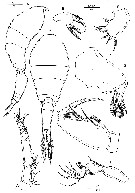 issued from : J.H. Wi, H.-L Suh, H.S. Yang & H.Y. Soh in Ocean Sci. J., 2008, 43 (4). [p.189, Fig.4]. Female (from Yellow Sea, Korea waters): A-B, habitus (lateral and dorsal, respectively); C, A1; D, A2; E, Md; F, Mx1; G, Mx2; H, Mxp.
|
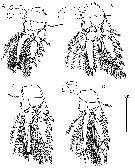 issued from : J.H. Wi, H.-L Suh, H.S. Yang & H.Y. Soh in Ocean Sci. J., 2008, 43 (4). [p.190, Fig.5]. Female: A-D, P1 to P4.
|
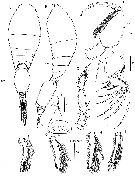 issued from : J.H. Wi, H.-L Suh, H.S. Yang & H.Y. Soh in Ocean Sci. J., 2008, 43 (4). [p.191, Fig.6]. Male: A-B, habitus (dorsal and lateral, respectively); C, A1; D, A2; E, Mxp; F-I, endopods of P1 to P4, respectively; J, P5; K, P6.
| | | | | Ref. compl.: | | | Selifonova & al., 2008 (p.305, Table 2); Böttger-Schnack & Schnack, 2009 (p.131, Table 3); Gubanova & al., 2013 (in press, p.4, Table 2) | | | | NZ: | 10 | | |
|
Carte de distribution de Oncaea venella par zones géographiques
|
| | | | | | | | | | | | | Loc: | | | Angola, Brazil (Rio de Janeiro), S Cape Verde Is., off Morocco-Mauritania, Medit. (Balearic Basin, Tyrrhenian Sea, Strait of Sicily, Ionian Sea, Lebanon Basin, Black Sea), G. of Aqaba, Red Sea (N-S), Arabian Sea, Seychelles Is., Australia (North West Cape), Baja California, Panama (Pacif.), E Korea | | | | N: | 26 (provably more because imperfect determination withO. venusta) | | | | Lg.: | | | (11) F: 0,91-0,85; (35) F: 1,07-0,92; (139) F: ± 0,98; (180) F: 0,95-0,87; (248) F: 0,92-0,85; M: 0,63-0,58; (332) F: 0,95-0,9; M: 0,73-0,67; (336) F: 1,09-0,81; M: 0,91-0,61; (651) F: 1,02-0,82; M: 0,84-0,61; (788) F: 0,88-0,75; M: 0,65-0,55; 0,73; (819) F: 0,75-0,88; (833) F: 0,94-0,86; M: 0,65-0,62; (1020) F: 0,80-0,83; M: 0,56-63; (1047) F: 0,85; {F: 0,75-1,09; M: 0,55-0,91} | | | | Rem.: | Farran (1929) caractérise cette variété par ses dimensions. Heron (2002) considère cette variété comme une véritable espèce (d'après essentiellement ses dimensions et quelques menus détails morphologiques), et la distingue d'une nouvelle espèce O. frosti (voir remarque à cette espèce).
Sa présence dans le Pacifique Est est confirmée; cependant Böttger-Schnack & Huys (2004) contestent les localisations géographiques de cette forme non toujours valablement identifiée, voire l'existence même de cette espèce qui ne correspond qu'à une simple forme.
Observé dans les ballasts des navires à San Francisco.
Voir aussi les remarques en anglais | | | Dernière mise à jour : 26/12/2017 | |
|
|
 Toute utilisation de ce site pour une publication sera mentionnée avec la référence suivante : Toute utilisation de ce site pour une publication sera mentionnée avec la référence suivante :
Razouls C., Desreumaux N., Kouwenberg J. et de Bovée F., 2005-2025. - Biodiversité des Copépodes planctoniques marins (morphologie, répartition géographique et données biologiques). Sorbonne Université, CNRS. Disponible sur http://copepodes.obs-banyuls.fr [Accédé le 04 décembre 2025] © copyright 2005-2025 Sorbonne Université, CNRS
|
|
 |
 |










